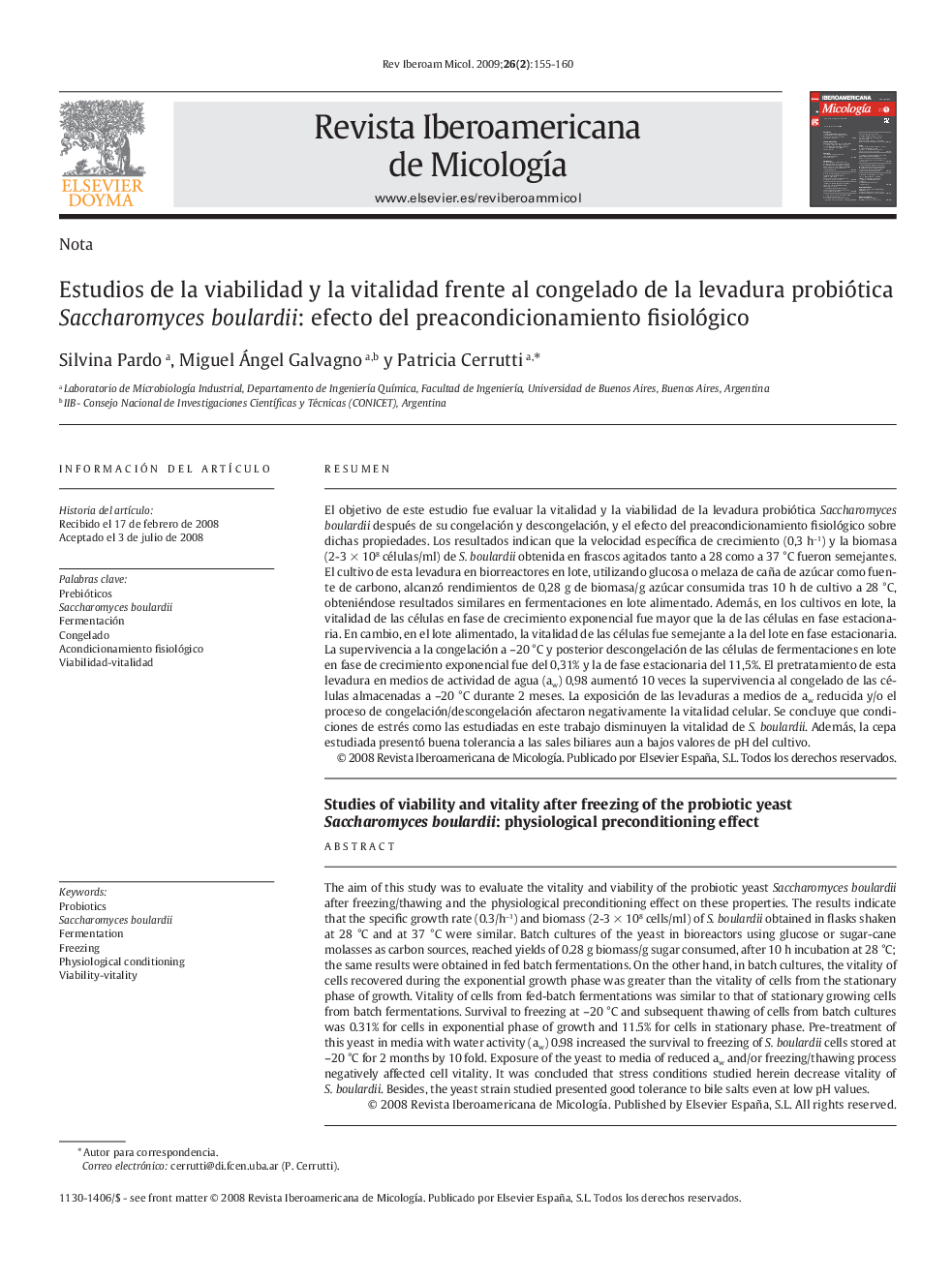| کد مقاله | کد نشریه | سال انتشار | مقاله انگلیسی | نسخه تمام متن |
|---|---|---|---|---|
| 3419038 | 1225795 | 2009 | 6 صفحه PDF | دانلود رایگان |

ResumenEl objetivo de este estudio fue evaluar la vitalidad y la viabilidad de la levadura probiótica Saccharomyces boulardii después de su congelación y descongelación, y el efecto del preacondicionamiento fisiológico sobre dichas propiedades. Los resultados indican que la velocidad específica de crecimiento (0,3 h−1) y la biomasa (2-3 × 108 células/ml) de S. boulardii obtenida en frascos agitados tanto a 28 como a 37 °C fueron semejantes. El cultivo de esta levadura en biorreactores en lote, utilizando glucosa o melaza de caña de azúcar como fuente de carbono, alcanzó rendimientos de 0,28 g de biomasa/g azúcar consumida tras 10 h de cultivo a 28 °C, obteniéndose resultados similares en fermentaciones en lote alimentado. Además, en los cultivos en lote, la vitalidad de las células en fase de crecimiento exponencial fue mayor que la de las células en fase estacionaria. En cambio, en el lote alimentado, la vitalidad de las células fue semejante a la del lote en fase estacionaria. La supervivencia a la congelación a –20 °C y posterior descongelación de las células de fermentaciones en lote en fase de crecimiento exponencial fue del 0,31% y la de fase estacionaria del 11,5%. El pretratamiento de esta levadura en medios de actividad de agua (aw) 0,98 aumentó 10 veces la supervivencia al congelado de las células almacenadas a –20 °C durante 2 meses. La exposición de las levaduras a medios de aw reducida y/o el proceso de congelación/descongelación afectaron negativamente la vitalidad celular. Se concluye que condiciones de estrés como las estudiadas en este trabajo disminuyen la vitalidad de S. boulardii. Además, la cepa estudiada presentó buena tolerancia a las sales biliares aun a bajos valores de pH del cultivo.
The aim of this study was to evaluate the vitality and viability of the probiotic yeast Saccharomyces boulardii after freezing/thawing and the physiological preconditioning effect on these properties. The results indicate that the specific growth rate (0.3/h−1) and biomass (2-3 × 108 cells/ml) of S. boulardii obtained in flasks shaken at 28 °C and at 37 °C were similar. Batch cultures of the yeast in bioreactors using glucose or sugar-cane molasses as carbon sources, reached yields of 0.28 g biomass/g sugar consumed, after 10 h incubation at 28 °C; the same results were obtained in fed batch fermentations. On the other hand, in batch cultures, the vitality of cells recovered during the exponential growth phase was greater than the vitality of cells from the stationary phase of growth. Vitality of cells from fed-batch fermentations was similar to that of stationary growing cells from batch fermentations. Survival to freezing at –20 °C and subsequent thawing of cells from batch cultures was 0.31% for cells in exponential phase of growth and 11.5% for cells in stationary phase. Pre-treatment of this yeast in media with water activity (aw) 0.98 increased the survival to freezing of S. boulardii cells stored at –20 °C for 2 months by 10 fold. Exposure of the yeast to media of reduced aw and/or freezing/thawing process negatively affected cell vitality. It was concluded that stress conditions studied herein decrease vitality of S. boulardii. Besides, the yeast strain studied presented good tolerance to bile salts even at low pH values.
Journal: Revista Iberoamericana de Micología - Volume 26, Issue 2, June 2009, Pages 155–160